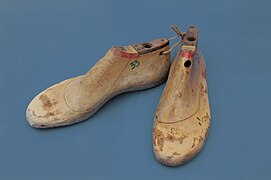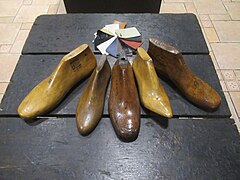Last
Appearance


A last is a mechanical form shaped like a
shoe production, immediately improving quality, halving prices, and eliminating the previous putting-out systems
surrounding shoemaking centers.
Name
The
History


Although
in the 17th century made shoemaking more complicated than previously.[3] It was not until the beginning of industrial production and mass marketing
in the early 19th century that lasts were again generally made and used in matching pairs. Generic one-size lasts are now only used for basic shoe repair.
Well into the
patented in 1883. This instantly centralized production, increased production by as much as 14 times, improved quality, and halved prices.[4][7][8]
Design
A last is a mechanical form shaped like a
bespoke footwear. Though a last is typically made to approximate the shape of a human foot, the precise shape is tailored to the kind of footwear being made. For example, boot lasts typically hug the instep for a close fit. Modern last shapes are now usually designed with dedicated CAD software
.
Lasts are typically made from
high-density polyethylene plastic (HMW-HDPE), which can be easily, cheaply, and precisely shaped; which withstand more damage from the tacks before requiring repair or replacement; and which can be recycled once they finally do wear out entirely. Wooden lasts are now used only for repair work and bespoke shoemaking, particularly in Europe and North America
.
Custom lasts
Cordwainers often use lasts that are specifically designed to the proportions of individual customers' feet. Made from wood or from various modern materials, they don't need to withstand the pressures of mass production machinery, but they must be able to handle constant tacking and pinning and the wet environment associated with stretching and shaping materials such as leather.
Gallery
- Lasts
-
A pair of wooden lasts
-
Tripartite metal last
-
Replaceable metal last on stand
-
Wooden lasts (Marikina Shoe Museum)
See also
References
Citations
- ^ Ringe (2017), p. 284.
- ^ Kurtz (2014), p. 1168.
- ^ SCM (2010a).
- ^ a b Mulligan (1981).
- ^ SCM (2010b).
- ^ Cutter & al. (2021).
- ^ Chamberlain (2012).
- ^ Lienhard (2000).
- ^ Enc. Brit., 11th ed. (1911).
- ^ Luximon & al. (2013), p. 177.
Bibliography
- Chisholm, Hugh, ed. (1911). "Last". Encyclopædia Britannica (11th ed.). Cambridge University Press..
- "History of Shoemaking in Britain—Tudors and Stuarts", Heart & Sole: Boot and Shoe Making in Staffordshire, Shugborough: Staffordshire County Museum, 9 December 2010, archived from the original on 2014-02-19.
- "History of Shoemaking in Britain—Napoleonic Wars and the Industrial Revolution", Heart & Sole: Boot and Shoe Making in Staffordshire, Shugborough: Staffordshire County Museum, 9 December 2010, archived from the original on 2014-02-02.
- Chamberlain, Gaius (23 March 2012), "Jan Matzeliger", Black Inventor Online Museum, Adscape International, archived from the original on 2012-02-19.
- Cutter, William Richard; et al. (2021), "John Brooks Nichols", Fiddlebase.
- Kurtz, Jean-Paul (2014). Dictionnaire Etymologique des Anglicismes et des Américanismes [Etymological Dictionary of Anglicisms and Americanisms]. Books on Demand. ISBN 9782322027385..
- Lienhard, Jan H. (2000), "No. 522: Jan Matzeliger", Engines of Our Ingenuity, Houston: University of Houston.
- Luximon, Ameersing; et al. (2013). Handbook of Footwear Design and Manufacture. Elsevier Science. ISBN 978-0-85709-879-5..
- Mulligan, William H. Jr. (March 1981). "Mechanization and Work in the American Shoe Industry: Lynn, Massachusetts, 1852–1883". The Journal of Economic History. 41 (1). JSTOR 2120894..
- Ringe, Donald A. (2017). From Proto-Indo-European to Proto-Germanic. Oxford: Oxford University Press. ISBN 978-0-19-879258-1..
External links
![]() Media related to Lasts at Wikimedia Commons
Media related to Lasts at Wikimedia Commons
- History of lastmaking (lastmakingschool.com)
- What is a shoe last? (shoemakingcoursesonline.com)




